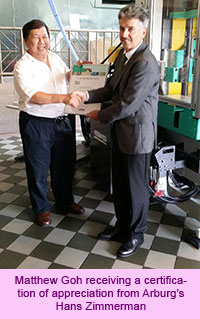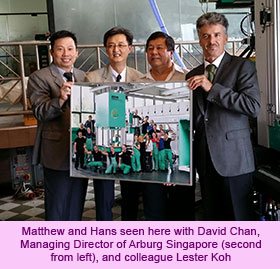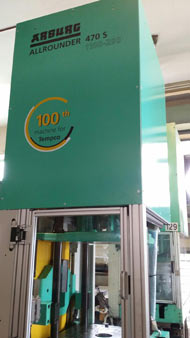Tempco takes delivery of 100th machine; to continue on innovation stride

Double eleven (11 November) was a significant day for Singapore moulder Tempco Manufacturing. While 11 November is “Singles’ Day” in China, a holiday where unmarried Chinese go on a shopping orgy for merchandise, Tempco upped the tempo with its own shopping spree for a machine, its 100th!
In a ceremony scheduled at the auspicious time of 11 am (thus making it triple eleven!), the company’s Managing Director Matthew Goh took delivery of the 100th injection moulding machine from German machinery maker Arburg.
One of Arburg’s largest customers in Southeast Asia, Tempco has since it started in 1983, relied on Arburg for machinery, according to Goh. “We have a full range from 15 to 500 tonnes from injection to injection/compression, vertical and rotary table types, including the latest Freeformer for 3D prototyping,” he said.
“We try not to buy the same model. Each machine has a special screw system. We instead suit the machine to the parts to be produced,” added Goh. It is for this reason that not all the machines run all the time. “About 30% of our machines are idle,” said Goh. “But when there are parts to be produced, the set up time is minimal and turnaround faster,” he says.
Besides the presses, the 12,000 sq m facility also houses 50 CNC deflashing and three prototyping machinery. It also has an in-house tooling workshop that produces around 30 moulds/month.

This makes Tempco an excellent “showroom” for Arburg in Asia, as it showcases machines that are in actual production. Not surprisingly, Arburg has its regional office next door to Tempco. “We are open to visitors coming to our factory. We like to share our knowledge,” adds Goh.
Reputedly one of the largest BMC (bulk moulding compound) processors in the region, Tempco specialises in moulding parts for the electric/electronics sector (circuit protection) and for the medical sector (biotech devices) for customers like GE, Schneider, Terasaki Electric and Hager.
When asked why he ventured into this sector, Goh says, “It is a niche sector, though it requires high investment since the gestation period for these products is usually four years so we need to have the staying power.”
A hands-on person, Goh learnt the ropes on the job. After a ten-year stint with GE, he set out on his entrepreneurial path.
He says that the full potential of BMC has not been realised yet. “Many plastic engineers do not know much about BMC. It is an industry that is waiting to be exploited.”
BMC is a doughy mass that is a polyester-based, thermoset composite. The BMC part can be produced as soon as the BMC compound has been mixed, with glass fibres and calcium carbonate filler to render strength, flame retardancy, mechanical and electrical/heat insulation and conductivity.
While BMC used to be popular as a low-cost drop-in for non-aesthetic, high heat applications, through the use of new chemical additives, it now offers other opportunities.
“BMC is revolutionary as not only can it replace engineering plastics and die casting, but with innovative mould designs and quality machines, aesthetics can be added on.”

Since Tempco also specialises in thermoplastics moulding, the company is able to “cross sell” its technology and ultimately use its expertise to solve problems. One example is the development of a technology that can increase the flexural strength of normal thermoplastics by more than ten times, without additional costs. “The technology is related to BMC, to get rid of bubbles in thermoplastics so that end products do not have cracks internally and are stronger,” explained Goh.
The affable Goh certainly has a big appetite – for innovation. Another six Arburg micromoulding and high-speed moulding machines will be delivered early next year. “We plan to use the machines for thinwall moulding of circuit breakers, using a hybrid of thermosetting and thermoplastics processing,” he says, adding that this has not been done before.
Already, Goh is planning on taking the company to the next level of processing, to produce parts for renewable technologies like fuel cells and wind/water turbines. “When the prices for energy go up, people will turn to renewable energy, so we have to be ready for it when it happens.”
What drives him? “The key to success is to do what other people are not doing yet,” Goh replies, with a broad smile, adding that the way forward for Tempco, which has been growing at 20% a year, is stronger growth.
(PRA)Copyright (c) 2015 www.plasticsandrubberasia.com. All rights reserved.









































